‘Flesh’ is a temporary exhibition at the York Art Gallery that explores how artists investigate and represent the body in their work. The website states that the exhibition raises questions about the body and ageing, race and gender, touch and texture and surface and skin . In Social Inequalities: Contemporary Debates, students are asked to reflect on disability, age and sexuality through the lens of bodies and identities amongst others. A common thread that connects all these issues is the importance of the body/ies in the process of identity formation. We reflect on the idea of inequalities being ‘under our skin’ (Gunaratnam 2013) and how some bodies emanate power whilst others are restrained, controlled, objectified, harmed, left to die, killed… If some inequalities are under our skin, what can we do as agents to resist the impoverishment of life chances that is faced by individuals in society? In this post, sociology students at York St John attempt to make the artworks relevant to the study of social inequalities.
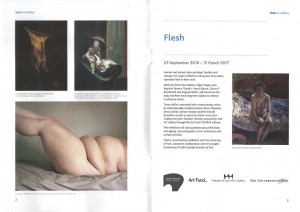
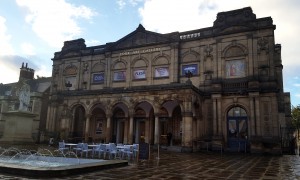
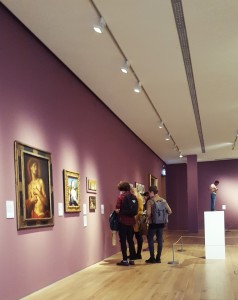
Cosmetic surgery
Jonathan Yeo’s ‘Augmentation’ (2011) and ‘A Picture of Health: Property of Jo Spence?’ (1982) by Jo Spence, both explore themes of the body and surgery, however the medical discourse explored in each is different. It is clear in Spence’s piece that the surgery was for medical, and so practical, reason. This differs from Yeo’s painting which uses surgery for material purpose. There were over 50,000 plastic surgery procedures performed in the UK in 2013 (British Association of Aesthetic Plastic Surgeons, 2014). This statistic highlights the relevance of Yeo’s work, as themes of self-esteem, quality of life, shame and other psychological and social issues are central to the reasons why many people, particularly women, have plastic surgery.
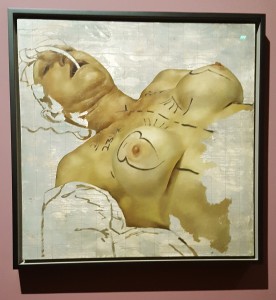
Jonathan Yeo (b. 1970), Secondary Augmentation Mastoplexy LOW (2011)
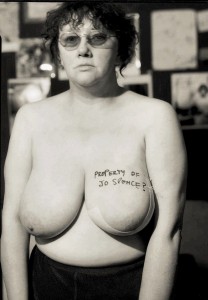
Jo Spence (1934-19992), A Picture of Health: Property of Jo Spence? (1982)
When examining the body and modernity, it is easy to see why people have cosmetic surgery. Bordo (1993:16) highlights that “culture’s grip on the body is constant”, hence the relevance of cosmetic surgery, as there are social pressures that change people’s views of themselves and their bodies. Societies’ norms around the body place pressure on people to fit into the ideal, seen every day in the media (Ricciardelli & Clow, 2009), which can pressure to conform to the sexualised and unrealistic image of women implicated by men (and vice-versa), the desire to be thin and have the ‘right’ breasts appears to be the dominant ideal in contemporary British society (Bordo, 1993).
Linking back to Yeo’s work, it is important to discuss the reasons why women have this particular type of surgery. Many scholars argue that women have breast augmentation to help their self-esteem (Crerand et al, 2007; Zuckerman et al, 2016). However, it has also been suggested that women who feel the need to conform to achieving the ideal body are instead more likely to have depression or anxiety (Meningaud et al, 2003). Both of these issues are present in the painting. There is a focus on the breasts as a popular form of cosmetic surgery, but also part of the face, which appears saddened and then fades. This could highlight the lack of mental stability in some patients who exhibit anxiety and so turn to cosmetic surgery. Clearly, Yeo’s painting supports the view that women who undergo surgeries of this type lack self-esteem, perhaps linking to studies which suggest that women who have cosmetic surgery have high suicide rates (McLaughlin et al, 2004). This presents a link to Spence’s photograph, as it is clear that in this situation the patient has lost ownership of her body because of her illness; her body is the property of medicine.
Nevertheless, there are feminist scholars suggesting that women can use plastic surgery to not only conform to body ideals, but also to rebel against these norms; Clow (2009) argues that with the increased normalisation and acceptance of body modification comes the opportunity for some women to express their independence and individuality either with or against body ideals, because of the commodification of the medical industry. Furthermore, we can also use Foucault’s notion of discipline to illustrate how using self-surveillance, people can choose either to regulate their bodies by following the norm, or go against it.
Overall, it is clear that there are differing and changing views of cosmetic surgery, although people may be becoming more accepting of cosmetic surgery (Adams, 2012), the health risks and psychology of the patients/consumers is clearly a focus point for many scholars and indeed artists such as Yeo. Furthermore, we must also consider those that have surgery for medical reasons and do not achieve a desirable outcome and their views of surgery.
Representation of old age
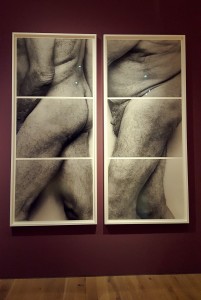
John Coplans (1920-2003), Frize No.6, Two Panels (1994, printed 2002)
John Coplan’s, Frieze No.6 Two Panels (1994) is a self-portrait that represents an ageing body. Coplan looks at the truths of the body rather than focusing on young airbrushed pictures. The use of tight cropping and the white grid on the portrait could create a claustrophobic feel as if the body will not fit into the formal structure which is expected of it. This may reflect the idealistic body image that is held within society due to media portrayals.
Coplan’s portrait could in some ways be linked to Harold Gilman’s painting, Interior with Nude. Old bodies are normally seen as asexual, whereas these two pieces could bring in the notion of sexual desire and reclaiming sexuality within an ageing body. Mainstream media often publish images of women in a way that emphasises the sexual nature of their bodies; the fact that Coplan obscures his head could be linked to this idea of sexualisation. In Gilman’s painting it could argued to be a deviant representation of the older body, in that the woman isn’t hiding any part of her. It suggests her not to be the stereotypical passive woman that was expected within that era, in fact she could be seen as a sexual agent.
No Control: Representations of gender
In the exhibit Flesh, featured at the York Art Gallery, there are three pieces that serve to highlight themes of masculinity vs femininity, action vs passivity, and agency vs control over the female body.

Pieter Claesz Soutman (1593-1657), Samson and Delilah (1642)
The story of Samson and Delilah depicted in this work is a biblical one. Samson was given strength by God, which was derived through the length of his hair. Delilah was a woman he loved. In the story Delilah is bribed by the Philistines to lull Samson to sleep, so they may cut his hair and take away his God-given strength. This story and this painting reminds us of the Cartesian dichotomy of mind and body, as well as the long understood notion that men were creatures of the mind and women of the body, therefore justifying patriarchy and the objectification of women. It seems the women in this painting are inactive and are represented as passive tools as the active man takes the strength from another man. We argue that the conflict is between the men, and the women are only bodies used for the agendas of these men. This reflects the ideas of women in society at the time and remind us of the representational issues women still face today.
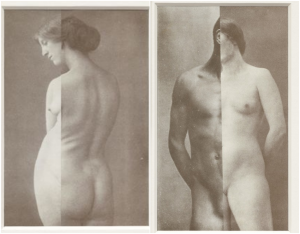
John Stezaker (b. 1949), Fall XII and Fall XIII (1992)
In Fall XII and Fall XIII (1992), Stezaker uses collage to embody the images of masculinity and femininity. To do so, however, in both pieces he uses both male and female bodies, and in doing so he highlights the essence of masculinity and femininity as social constructs rather than fixed truths of the body. These images visualize the discussion of corporeality vs sociality and suggest that the aspects of gender go beyond biological bodies.
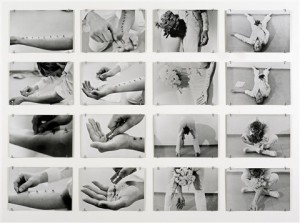
Gina Pane (1939-1990), Azione Sentimentale (1973)
Gina Pane’s ‘Azione Sentimentale’ (1973) performance art focuses on the pleasures and pains of the body, and in most of her pieces she inflicts pain on herself to derive empathy and critical thinking from her audience and viewers. These photographs depict Pane inflicting injury on herself by piercing her arm with rose thorns and cutting her hand with a razor blade. One can easily suggest that this performance represents the pain suffered by women and female bodies. However, we argue there is a sense of agency and control over this pain. Pane methodically positions the thorns in a line down her forearm and then cuts her palm at the end of the line, transferring the image of the red rose from the physical roses she holds to the visual representation on her arm. The thorns in this case act as the stem and the blood acts as the petals. This sense of beauty in pain and self-inflicted injury suggests an idea of reclaiming the bodies of women and females. We argue by choosing when and how she feels pain, Pane is taking agency over her own body and, even if for only a moment, refuting the pain and injustice pressed upon her body and mind by the society in which she has no control.
Representation of race in The Wrestlers
Within this William Etty’s painting (c. 1840) we are presented with a black man and a white man wrestling. It could be seen that the white man is wearing a rag, whereas the black man is naked and exposed. This could suggest that only the privileged has access to clothing which highlights there is a divide between the two people in the painting. As well as this, the black man’s face is not shown on the painting, this is suggesting that this man is more animalistic than intellectual and more connected to nature. Furthermore, the towering position of the white man could reflect the era in which they lived in. This is because he is in a stronger and more dominating position, which could highlight how ethnic minorities were repressed and controlled by white supremacy.
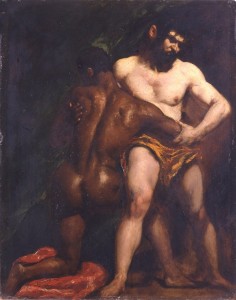
William Etty (1787-1849), The Wrestlers (c. 1840)
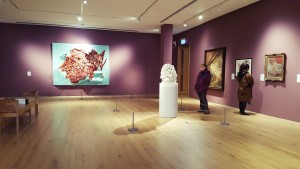
Bibliography
ADAMS, J., 2012. Cleaning up the Dirty Work: Professionalization and the Management of Stigma in the Cosmetic Surgery and Tattoo Industries. Deviant Behaviour. 33(3), pp149-167.
BORDO, SUSAN., 1993. Unbearable Weight. Berkeley: University of California Press.
BRITISH ASSOCIATION OF AESTHETIC PLASTIC SURGEONS., 2014 [last update]. Online, available at http://baaps.org.uk/about-us/press-releases/1833-britain-sucks [accessed 21-Oct-16].
CRERAND, C.E., INFIELD, A.L., and SARWER.D.B., 2007. Psychological Considerations in Cosmetic Breast Augmentation. Plastic Surgical Nursing. 27(3), pp146-154.
GUNARATNAM, Y. 2003. Death and the Migrant: Bodies, Borders and Care. London: Bloosmbury Academic.
MCLAUGHLIN, J.K., WISE, T.N., and LIPWORTH, L., 2004. Perspective: Increased Risk of Suicide Among Patients with Breast Implants: Do the Epidemiologic Data Support Psychiatric Consultation? Psychosomatics. 45(4), pp277-280.
MENINGAUD, J.P., BENADIBA, L., SERVANT, J.M., HERVE, C., BERTRAND, J.C., and PELICIER, Y., 2003. Depression, Anxiety and Quality of Life: Outcome 9 Months After Facial Cosmetic Surgery. Journal of Cranial-Maxillofacial Surgery. 31(1), pp46-50.
RICCIARDELLI, ROSEMARY., and CLOW, KIMBERLEY., 2009. Men, Appearance and Cosmetic Surgery: The Role of Self-Esteem and Comfort with the Body. Canadian Journal of Sociology, 34(1), pp105-134.
ZUCKERMAN, D.M., KENNEDY, C.E., and TERPLAN, M., 2016. Breast Implants, Self-Esteem, Quality of Life and the Risk Suicide. Women’s Health Issues. 26(4), pp361-















